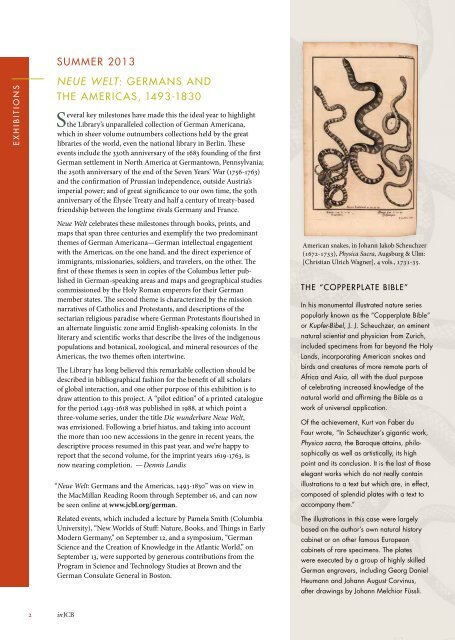You also want an ePaper? Increase the reach of your titles
YUMPU automatically turns print PDFs into web optimized ePapers that Google loves.
EXHIBITIONS<br />
summer 2013<br />
NEUE WELT: GERMANS AND<br />
THE AMERICAS, 1493-1830<br />
Several key milestones have made this the ideal year to highlight<br />
the Library’s unparalleled collection of German Americana,<br />
which in sheer volume outnumbers collections held by the great<br />
libraries of the world, even the national library in Berlin. These<br />
events include the 330th anniversary of the 1683 founding of the first<br />
German settlement in North America at Germantown, Pennsylvania;<br />
the 250th anniversary of the end of the Seven Years’ War (1756-1763)<br />
and the confirmation of Prussian independence, outside Austria’s<br />
imperial power; and of great significance to our own time, the 50th<br />
anniversary of the Élysée Treaty and half a century of treaty-based<br />
friendship between the longtime rivals Germany and France.<br />
Neue Welt celebrates these milestones through books, prints, and<br />
maps that span three centuries and exemplify the two predominant<br />
themes of German Americana—German intellectual engagement<br />
with the Americas, on the one hand, and the direct experience of<br />
immigrants, missionaries, soldiers, and travelers, on the other. The<br />
first of these themes is seen in copies of the Columbus letter published<br />
in German-speaking areas and maps and geographical studies<br />
commissioned by the Holy Roman emperors for their German<br />
member states. The second theme is characterized by the mission<br />
narratives of Catholics and Protestants, and descriptions of the<br />
sectarian religious paradise where German Protestants flourished in<br />
an alternate linguistic zone amid English-speaking colonists. <strong>In</strong> the<br />
literary and scientific works that describe the lives of the indigenous<br />
populations and botanical, zoological, and mineral resources of the<br />
Americas, the two themes often intertwine.<br />
The Library has long believed this remarkable collection should be<br />
described in bibliographical fashion for the benefit of all scholars<br />
of global interaction, and one other purpose of this exhibition is to<br />
draw attention to this project. A “pilot edition” of a printed catalogue<br />
for the period 1493-1618 was published in 1988, at which point a<br />
three-volume series, under the title Die wunderbare Neue Welt,<br />
was envisioned. Following a brief hiatus, and taking into account<br />
the more than 100 new accessions in the genre in recent years, the<br />
descriptive process resumed in this past year, and we’re happy to<br />
report that the second volume, for the imprint years 1619-1763, is<br />
now nearing completion. — Dennis Landis<br />
“Neue Welt: Germans and the Americas, 1493-1830” was on view in<br />
the MacMillan Reading Room through September 16, and can now<br />
be seen online at www.jcbl.org/german.<br />
Related events, which included a lecture by Pamela Smith (Columbia<br />
<strong>University</strong>), “New Worlds of Stuff: Nature, Books, and Things in Early<br />
Modern Germany,” on September 12, and a symposium, “German<br />
Science and the Creation of Knowledge in the Atlantic World,” on<br />
September 13, were supported by generous contributions from the<br />
Program in Science and Technology Studies at <strong>Brown</strong> and the<br />
German Consulate General in Boston.<br />
American snakes, in Johann Jakob Scheuchzer<br />
(1672-1733), Physica Sacra, Augsburg & Ulm:<br />
[Christian Ulrich Wagner], 4 vols., 1731-35.<br />
THE “COPPERPLATE BIBLE”<br />
<strong>In</strong> his monumental illustrated nature series<br />
popularly known as the “Copperplate Bible”<br />
or Kupfer-Bibel, J. J. Scheuchzer, an eminent<br />
natural scientist and physician from Zurich,<br />
included specimens from far beyond the Holy<br />
Lands, incorporating American snakes and<br />
birds and creatures of more remote parts of<br />
Africa and Asia, all with the dual purpose<br />
of celebrating increased knowledge of the<br />
natural world and affirming the Bible as a<br />
work of universal application.<br />
Of the achievement, Kurt von Faber du<br />
Faur wrote, “<strong>In</strong> Scheuchzer’s gigantic work,<br />
Physica sacra, the Baroque attains, philosophically<br />
as well as artistically, its high<br />
point and its conclusion. It is the last of those<br />
elegant works which do not really contain<br />
illustrations to a text but which are, in effect,<br />
composed of splendid plates with a text to<br />
accompany them.”<br />
The illustrations in this case were largely<br />
based on the author’s own natural history<br />
cabinet or on other famous European<br />
cabinets of rare specimens. The plates<br />
were executed by a group of highly skilled<br />
German engravers, including Georg Daniel<br />
Heumann and Johann August Corvinus,<br />
after drawings by Johann Melchior Füssli.<br />
2 in<strong>JCB</strong>
















